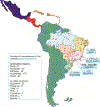Skeletal dysplasias in Latin America
- PMID: 33219737
- PMCID: PMC9827228
- DOI: 10.1002/ajmg.c.31861
Skeletal dysplasias in Latin America
Abstract
Skeletal dysplasias (SD) are disturbances in growth due to defects intrinsic to the bone and/or cartilage, usually affecting multiple bones and having a progressive character. In this article, we review the state of clinical and research SD resources available in Latin America, including three specific countries (Brazil, Argentina, and Chile), that have established multidisciplinary clinics for the care of these patients. From the epidemiological point of view, the SD prevalence of 3.2 per 10,000 births from nine South American countries included in the ECLAMC network represents the most accurate estimate not just in Latin America, but worldwide. In Brazil, there are currently five groups focused on SD. The data from one of these groups including the website www.ocd.med.br, created to assist in the diagnosis of SD, are highlighted showing that telemedicine for this purpose represents a good strategy for the region. The experience of more than 30 years of the SD multidisciplinary clinic in an Argentinian Hospital is presented, evidencing a solid experience mainly in the follow-up of the most frequent SD, especially those belonging the FGFR3 group and OI. In Chile, a group with 20 years of experience presents its work with geneticists and pediatricians, focusing on diagnostic purposes and clinical management. Altogether, although SD health-care and research activities in Latin America are in their early stages, the experience in these three countries seems promising and stimulating for the region as a whole.
Keywords: Latin America; achondroplasia; dysostosis; osteogenesis imperfecta; skeletal dysplasias; telemedicine.
© 2020 Wiley Periodicals LLC.
Conflict of interest statement
CONFLICT OF INTEREST
None.
Figures
References
-
- Araújo TF, Ribeiro EM, Arruda AP, Moreno CA, de Medeiros PF, Minillo RM, … Cavalcanti DP (2016). Molecular analysis of the CTSK gene in a cohort of 33 Brazilian families with pycnodysostosis from a cluster in a Brazilian Northeast region. European Journal of Medical Research, 21(1), 33. 10.1186/s40001-016-0228-7 - DOI - PMC - PubMed
Publication types
MeSH terms
Grants and funding
LinkOut - more resources
Full Text Sources


